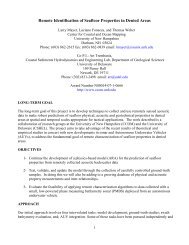High Precision Acoustic Positioning â HiPAP® - Kongsberg Maritime
High Precision Acoustic Positioning â HiPAP® - Kongsberg Maritime
High Precision Acoustic Positioning â HiPAP® - Kongsberg Maritime
Create successful ePaper yourself
Turn your PDF publications into a flip-book with our unique Google optimized e-Paper software.
<strong>High</strong> <strong>Precision</strong> <strong>Acoustic</strong> <strong>Positioning</strong> – HiPAP ®<br />
www.kongsberg.com
The HiPAP Family:<br />
HiPAP 501<br />
HiPAP 451<br />
HiPAP 351<br />
HiPAP 351P series<br />
HiPAP 101<br />
Maximizing<br />
performance<br />
by providing The Full Picture<br />
Our mission<br />
We shall earn the respect and recognition for our dedication to provide innovative and<br />
reliable marine electronics that ensure optimal operation at sea. By utlilising and integrating<br />
our technology, experience and competencies in positioning, hydroacoustics, communication,<br />
control, navigation, simulation, and automation, we aim to give our customers<br />
The Full Picture. The Full Picture yields professional solutions and global services that make<br />
a difference enabling you to stay ahead of the competition.<br />
Our philosophy<br />
Our success depends on the success of our customers. Actively listening to our customers<br />
and truly understanding their needs, and then translating these needs into successful products<br />
and solutions is central to achieving our goal.<br />
Our people are the key to our success and we empower them to achieve. Working together<br />
in a global network of knowledge, guided by our values, engenders innovation and world class<br />
performance. Every day we have to think a little differently, because every client is unique.<br />
We aspire to translate the imagination and dedication of our staff into successful<br />
technologies and solutions. Our commitment is to add value to your operations by providing you<br />
with The Full Picture.
<strong>High</strong> <strong>Precision</strong> <strong>Acoustic</strong> <strong>Positioning</strong> – HiPAP ®<br />
Introduction<br />
The HiPAP family consists of the world’s most successful underwater positioning systems.<br />
It was first developed with focus on the Super Short Base Line (SSBL) principle, as this<br />
was a market requirement of trying to avoid the Long Base Line (LBL) principle in deep<br />
water and in accurate seabed survey applications.<br />
The main advantage of the SSBL principle is that it only requires installation of one<br />
vessel-mounted transducer and one subsea transponder. The unique transducer<br />
technology and advanced digital signal processing was found to be the ideal solution for<br />
obtaining the optimal position accuracy required in deeper waters.<br />
The HiPAP Model 501/451/351/101 systems are the second generation HiPAP systems.<br />
These models have a new transceiver unit and possibility to operate Cymbal. Cymbal is<br />
KM’s new acoustic protocol for positioning and communication. All HiPAP systems;<br />
HiPAP 501, HiPAP 451, HiPAP 351 and HiPAP 101 have common software and hardware<br />
platforms, and thereby offer the same kind of additional functionality and options.<br />
Extreme accuracy - a quantum leap<br />
The HiPAP 501 establishes subsea positioning so accurate that the more complex, but<br />
common, LBL principle is made redundant within reasonable depths. Time and cost of<br />
survey operations are therefore reduced to a minimum.<br />
The HiPAP 501 system is a quantum leap in technology, with hundreds of elements in a<br />
spherical transducer. These elements enable an extremely high internal redundancy and<br />
reliability. The same advanced transducer core technology is utilised across the entire<br />
HiPAP family, together with digital acoustic signal processing, making HiPAP the most<br />
accurate and reliable SSBL systems available.<br />
The Hugin autonomous underwater vehicle<br />
3
Beam Forming – vital to suppress “damaging” noise<br />
The beam-former in HiPAP is digital. All transducer elements are individually<br />
interfaced to the Digital Signal Processor (DSP) which measures the phase and<br />
amplitude of the incoming signal to calculate the horizontal and vertical angle to<br />
the transponder. All HiPAP models use a unique and automated focusing of narrow<br />
transmitting and listening beams technology. The beams are totally formed by the<br />
DSP in the direction decided by the position-tracking algorithm (towards the<br />
transponder). Data from the vessel’s compass is input to the tracking algorithm in<br />
order to direct the beam in correct horizontal direction and also to stabilize the<br />
beam. The narrow beams provide improved Signal to Noise ratio (S/N) which is<br />
essential to obtain improved angle measurements accuracy and longer range<br />
capabilities. Further it suppresses the negative effect of acoustic reflections as well as<br />
suppressing noise coming from other directions.<br />
4
The positioning principles<br />
Super (Ultra) Short Base Line underwater positioning principle<br />
The SSBL (USBL) principle is clearly the simplest underwater positioning principle in<br />
operation. The Super Short Base Line refers to the very short distance between the<br />
active piezo-electric elements in the transducer, which is mounted under the vessel.<br />
The SSBL principle has the obvious advantage that it requires no installation of<br />
calibrated array transponders on the seabed. Only the targets that are to be<br />
positioned (one may well be at the seabed) must be equipped with a transponder. A<br />
SSBL system measures the horizontal and vertical angles together with the range to<br />
the transponder(s) giving a 3D position projection of the transponder(s) relative the<br />
vessel (vessel’s reference point). An error in the angle measurement causes the<br />
position error to be a function of the range to the transponder, so SSBL has therefore<br />
an accuracy error increasing with the range. To obtain better position accuracy in<br />
deep water with an SSBL system it is necessary to increase the angle measurement<br />
accuracy.<br />
SSBL positioning<br />
Long Base Line underwater positioning principle<br />
The LBL principle is somewhat more complex in operation. The Long Base Line refers<br />
to the base lines between transponders spread out on the seabed. This array of<br />
transponders needs to be calibrated, i.e. all ranges between them need to be<br />
measured. HiPAP systems have automated and advanced functionalities working on<br />
acoustic ranging and telemetry to find these ranges. Normally LBL gives more<br />
accurate positioning within the range of the transponder array and the LBL position<br />
accuracy is almost independent of depth.<br />
The <strong>High</strong> <strong>Precision</strong> <strong>Acoustic</strong> <strong>Positioning</strong> (HiPAP) systems family can utilise software<br />
for either or both SSBL and LBL principles.<br />
LBL positioning<br />
LBL positioning of underwater vehicles and structures<br />
5
The system modules<br />
Operator Unit with APOS – Worlds best Man Machine Interface<br />
All HiPAP systems use the same <strong>Acoustic</strong> <strong>Positioning</strong> Operating System (APOS) and<br />
Man Machine interface. The APOS consists of a Color Display, an <strong>Acoustic</strong> <strong>Positioning</strong><br />
Computer (APC), Keyboard and tracker-ball. The OS performs all user interfaces and<br />
controls the transceiver(s).<br />
The APOS is running on a Windows software template in the APC, which enables the<br />
operation of the HiPAP in a “Windows-like fashion”.<br />
Multiple Operator Stations are possible with no limit to how many onboard a vessel.<br />
They will be organised in a setup where one Operator Station will always be Primary and<br />
all the others will be Secondary. A Secondary Station may take Primary control at any<br />
time.<br />
Transceiver<br />
The Transceiver Unit is mounted close to the hull unit and contains advanced digital<br />
transmitters, preamplifiers and beam-forming electronics. The transceiver<br />
communicates with the Operating System (OS) via fiber optic cable(s).<br />
HiPAP’s Unique Transducers<br />
The HiPAP series of transducers have many more elements than any of its competitors.<br />
There is a clear connection between system performance and the number of elements.<br />
<strong>Acoustic</strong>al redundancy, mathematical redundancy and improvement of the Signal to<br />
Noise level are all factor in the high system performance of the HiPAP family.<br />
Except for the HiPAP 351P Portable transducer all the transducers are purely mechanical<br />
devices with internal ceramic elements, which maximize the reliability when compared to<br />
systems that also have electronics inside.<br />
6
The Important Hull Unit<br />
The HiPAP system operates with the transducer<br />
mounted on a hull unit, allowing it to be lowered<br />
several meters under the vessel’s hull. The transducer’s<br />
hull unit is mounted on a gate valve and takes the<br />
transducer down to a depth free from the aerated water<br />
created by the hull, propellers and thrusters, and also below the<br />
most critical surface water layers. <strong>Kongsberg</strong> hull units are<br />
guaranteed to withstand the water forces when the vessel runs up to<br />
10 knots. The hull unit is the same for all HiPAP transducers and come with<br />
different lengths.<br />
Transponders and Responders – more than 100 channels available<br />
The underwater target to be positioned must have a transponder or a responder<br />
installed. The transponder operates acoustically while the responder requires a cable for<br />
triggering.<br />
The various transponders models have different depth rating, source level, lifetime,<br />
beam pattern and function. There are two main transponder series, the MPT/SPT/MST<br />
series which are using traditional frequency shift (FSK) modulation technique and the<br />
New cNODE® transponder family which also can use the new Cymbal acoustic protocol.<br />
The new cNODE range of transponders are compatible with both HiPAP® Cymbal<br />
acoustic protocol for positioning and data link, and HiPAP®/HPR 400 channels and<br />
telemetry. It has a modular construction such that the transducer, transponder<br />
electronics, battery pack and optional add-on’s can be replaced individually. The<br />
Floating collars have been redesigned and are very user friendly and secure in use.<br />
The HiPAP MF systems (not HiPAP 101) may also position Diver Emergency Channels A<br />
and B, but at a reduced range (typical max range 1000m).<br />
Please see transponder family brochure for more details.<br />
7
Heading Sensor<br />
The HiPAP also needs to be interfaced to the vessel’s heading sensor (normally a gyro<br />
compass). The accuracy of this sensor will affect the overall positioning accuracy in the<br />
same way as the Roll/Pitch sensor. One reducing factor is that the effect will be<br />
relative to the horizontal offset between the vessel and the seabed transponder,<br />
meaning that the effect will be equal to zero if the vessel is directly above the<br />
transponder (which is often the case).<br />
Vertical Reference Sensor<br />
Since the HiPAP system measures an accurate underwater position from a ship<br />
mounted antenna (transducer) it is most important to compensate for the movements<br />
that the vessel has in Roll and Pitch using a Motion Reference Unit (MRU).<br />
From the above curves one can see that the quality of the MRU is most important to<br />
the overall positioning of the underwater “target” as the total position error will be the<br />
sum of the HiPAP and the MRU error budgets. The general rule must be; “Why ruin a<br />
high quality investment in a HiPAP system with a poor quality MRU”<br />
External Interfaces<br />
A HiPAP system as standard, is interfaced to both Heading and Vertical Reference<br />
sensors. A GNSS surface navigation system may also be interfaced in order to refer the<br />
subsea position data to absolute geographical coordinates.<br />
Error compensation caused by sound velocity variances<br />
APOS has the possibility to use a sound velocity profile to make real time corrections<br />
for errors introduced to angular ray bending and to distance in all measurements<br />
(SSBL and LBL).<br />
The profile can either be in the form of a text table (on electronic file), or it can be<br />
sent on serial line for online" compensation.<br />
8
Cymbal ® – the new state-of-the-art acoustic protocol<br />
The HiPAP Model 501/451/351/101 systems are the second generation HiPAP systems<br />
which have a new transceiver unit and may upgrade to the new Cymbal acoustic protocol<br />
utilizing the wideband Direct Sequence Spread Spectrum (DSSS) signals.<br />
The Cymbal protocol transmits more energy into the water and together<br />
with the uniqueness coding the following new advantages of the HiPAP<br />
systems are made available:<br />
- Increases angular accuracy with up to 30 % (SSBL improvement)<br />
- Longer range capability<br />
- Range accuracy is in the order of 0.02m (0,01m between cNODE transponders)<br />
- 50 additional unique transponder channels in addition to the "older" 56 channels<br />
- Improvement of multi path properties<br />
- Allows higher position update rate through MultiPing<br />
- Automatically adjustment of transponder TX power for increased battery endurance<br />
- <strong>High</strong> speed telemetry data rate (max 8kbit/s)<br />
- Supports variable telemetry data rate and high reliability level<br />
- Telemetry data will be interleaved between the positioning signals<br />
- Enables modeless change of transponders from SSBL and LBL and vice versa<br />
The position accuracy for LBL operation depends on the transponder array geometry,<br />
sound velocity errors and signal to noise ratio. Range accuracy’s down to a few<br />
centimetres can be obtained, while ROV and vessel positions can be calculated to within<br />
a few decimetres.<br />
The graph shows<br />
improvement in<br />
horizontal position<br />
error between<br />
continous wave<br />
and Cymbal.<br />
9
Functions and Applications<br />
Super Short Base Line – everybody wants it<br />
A transponder is deployed at the seabed, on a submerged structure or on an<br />
underwater vehicle. Vessel operators then want to know the position of this<br />
transponder and the HiPAP system operating in SSBL mode gives the operator this<br />
information by simply:<br />
“Pushing the button”<br />
Bird’s eye view of vessel and transponders<br />
The HiPAP system will then display the transponder position relative to the vessel or<br />
geographically, in numerical coordinates.<br />
It will also send the coordinates on serial line or Ethernet to external equipment.<br />
Simple and easy – it’s no wonder operators prefer this principle.<br />
Reliable underwater reference for DP systems<br />
No other acoustic positioning system has more built in experience than <strong>Kongsberg</strong>’s.<br />
HiPAP always sends raw position data to the Dynamic <strong>Positioning</strong> (DP) system, so<br />
that the DP itself can perform the evaluation, weighting and filtering of its<br />
references. Since <strong>Kongsberg</strong> is also one of the world’s major suppliers of DP systems<br />
we know the demands there are in the tough and noisy environment onboard vessels<br />
controlled by a DP. All HiPAPs can be can be integrated with HAIN Reference system.<br />
10
Accepted underwater positioning in the survey industry<br />
One of the major Survey & Construction companies has expressed that the HiPAP<br />
501 is a “quantum leap” in the area of underwater positioning. Due to continuous<br />
further developments and enhancements of the HiPAP technology, customers still<br />
find the system unprecedented and extremely reliable. Many oil companies use the<br />
HiPAP specifications as precedent in their demands when issuing tender documents.<br />
Long Base Line – sometimes a must<br />
At some point of range, depending on the application, the SSBL principle will have<br />
accuracy limitation. LBL accuracy is independent of range, but only within an array of<br />
seabed transponders. The HiPAP with optional LBL features implemented is a very<br />
flexible system combining the advantages of both SSBL and LBL. The HiPAP has<br />
better long range performance than traditional wide beam systems. This is due to the<br />
Signal-to-Noise ratio of the detected seabed transponders’ replies, which are higher<br />
than when using one wide beam that needs to cover the seabed footprint of a<br />
transponder array.<br />
Long Base Line – for positioning of underwater vehicles<br />
The HiPAP systems have fully integrated LBL functionality and are very flexible when<br />
combining the advantages of both SSBL and LBL principles. A vessel’s HiPAP<br />
Operator Station can also be interfaced to, and control a vehicle mounted LBL system.<br />
Long Base Line – for subsea construction<br />
<strong>Kongsberg</strong> <strong>Maritime</strong> introduced the LBL system in 1992, and has since become the<br />
market leader for supply of LBL and combined LBL/SSBL systems for vessel<br />
positioning. The current LBL systems use intelligent, instrumented transponders,<br />
transceivers and transducers. These are all rated for operations down to 4000 m<br />
water depth in medium frequency band and 6500m for HiPAP 101 in low frequency<br />
band, and fulfill any requirements within subsea construction, survey and metrology<br />
application.<br />
11
Dual HiPAP systems<br />
Use of two transducers will not only increase the electrical redundancy but also the<br />
acoustic redundancy, as one transducer may have a better location with respect to<br />
noise environments and reflections.<br />
With optional dedicated software the SSBL accuracy will improve with a factor of<br />
1/2 (see spec) based on the statistical improvements when using two independent<br />
systems.<br />
Operator Station Operator Station Operator Station<br />
Heading sensor<br />
Motion sensor<br />
GPS<br />
Ethernet<br />
Ethernet switch/<br />
Converter<br />
Heading sensor<br />
Motion sensor<br />
GPS<br />
Ethernet switch/<br />
Converter<br />
Ethernet<br />
Responder<br />
Driver Unit (option)<br />
Responder<br />
Ethernet<br />
Responder sync.<br />
Fibre A Fibre A<br />
Fibre B (optional) Fibre B<br />
Fibre Splice<br />
Box<br />
Dual Ethernet<br />
(Sync for Dual HiPAP only)<br />
Fibre Splice<br />
Box<br />
Fibre A Fibre A<br />
Fibre B (optional) Fibre B<br />
Ethernet<br />
Responder sync.<br />
Responder<br />
Driver Unit (option)<br />
Responder<br />
(Cd31085a)<br />
Transceiver Unit<br />
Model x81<br />
Hull Unit<br />
Hull Unit<br />
Transceiver Unit<br />
Model x81<br />
Hoist<br />
Control Unit<br />
Hoist<br />
Control Unit<br />
Remote<br />
Control<br />
Unit<br />
Remote<br />
Control<br />
Unit<br />
HiPAP 500/350<br />
transducer<br />
HiPAP 500/350<br />
transducer<br />
12
Multi User Long Base Line – positioning of many vessels and vehicles<br />
The Multi-User LBL (MULBL) function enables several individual vessels and ROV<br />
units to position themselves using the same seabed transponder array.<br />
Fully integration with Hydroacoustic Aided Inertial Navigation - HAIN<br />
<strong>Acoustic</strong> and Inertial positioning principles in combination is ideal, since they have<br />
complementary qualities. <strong>Acoustic</strong> positioning is characterised by relatively high and<br />
evenly distributed noise and no drift in the position, whilst inertial positioning has<br />
very low short-term noise and relatively large drift in the position over time.<br />
HAIN provides;<br />
• improved acoustic position accuracy<br />
• higher position update rate<br />
• extends operational depth capabilities<br />
• longer transponder-battery lifetime<br />
• position update during acoustic drop-out<br />
All HiPAP systems can be integrated with HAIN Subsea system for ROV’s and<br />
HAIN Reference system for rigs and vessels.<br />
For more information on HAIN see separate HAIN brochure.<br />
ROV operating in deep water using HAIN Subsea<br />
Blue: HiPAP SSBL Positions<br />
Green: HAIN Realtime Position<br />
Red: HAIN Post Processed Position<br />
Position improvement when using HAIN Reference<br />
13
HiPAP for drilling rigs and ships<br />
The HiPAP system can operate more than 100 transponders, providing all coordinates on<br />
the display. Position data output is also available. The system can denote transponderlocations<br />
at horizontal distances of up to 5-6 times the water depth, with increasing<br />
accuracy as the vessel gets closer to the required location. Vessel position will be given<br />
relative to any of the active reference transponders chosen by the operator, and all may<br />
be used with individual offsets in three dimensions. You can find the position of your<br />
template, stack, riser foot, ROV, Camera tool etc.<br />
• Underwater navigation<br />
• Underwater positioning<br />
• Riser angle and differential angle measurements<br />
• <strong>Acoustic</strong> Back-up Control of BOP<br />
HiPAP used for underwater navigation is cost and time efficient when positioning the<br />
drill-bit to its first specified geographical position or when re-entering an existing well<br />
marked with a transponder.<br />
<strong>Positioning</strong> of underwater vehicles and subsea tools relative to a fixed reference is<br />
performed simultaneously using transponders, responders or a combination of both.<br />
Lower <strong>Acoustic</strong> Riser Angle (ARA) measurements<br />
The HiPAP system is also capable of monitoring the riser angle by using an Inclinometer<br />
Transponder, which measurs both the X and the Y angle of the riser and sends the<br />
information by acoustic telemetry to the surface vessel. The accuracy is better than 0.25<br />
degree. The Differential Tilt Transponder can be used to monitor the relative angle<br />
between the BOP/stack and the riser (in the flex joint). Operator selected alarm limits for<br />
visual as well as audible alarm for BOP position and riser angle are available.<br />
14
Upper Electrical Riser Angle (ERA) Mode<br />
An Ex Proof Motion Reference Unit (MRU) mounted on the riser below the drill floor<br />
and below the flex-joint. This MRU is hard wired to the APOS (HiPAP’s <strong>Acoustic</strong><br />
<strong>Positioning</strong> Operating Station) and will provide angle readings. The APOS will process<br />
and display the actual differential angle measurements between the rig’s roll/pitch<br />
values, taken from the vessel mounted MRU, and the riser mounted MRU values.<br />
The ERA data is also available on serial line or Ethernet outputs.<br />
Sea current monitoring<br />
The HiPAP system can be used to read sea current speed and<br />
direction at given points on a drilling riser by reading<br />
transponders interfaced to DVL sea current sensors.<br />
<strong>Acoustic</strong> Control System (ACS) for operating the valve<br />
functions on the BOP<br />
The valves on a Blow-Out-Preventer (BOP) are activated to<br />
operate by either using a hydraulic primary system or by<br />
using an acoustic system where signals from “above” are<br />
transmitted through the water column. The ACS system is<br />
always delivered with a small command unit connected to a<br />
portable over-the-side dunking transducer. These units are<br />
designed for taking onto a lifeboat, a standby vessel, or into<br />
a helicopter in emergency (read: Blow-Out) so that the<br />
operator can close down the BOP.<br />
The HiPAP can also have software for operating with the<br />
<strong>Kongsberg</strong> ACS, which can operate the valves on the BOP.<br />
The HiPAP’s hull mounted transducer is then used to perform<br />
telemetry to the Subsea parts in combination with the<br />
positioning tasks.<br />
For maintenance routine testing it is much more convenient<br />
to use HiPAP than performing the testing from the deck with<br />
a portable system.<br />
15
Models of the HiPAP family<br />
The HiPAP 501 – “Top-of-the-range” and fully omni directional<br />
The grand success of underwater positioning systems with more than 1100 systems<br />
sold per January 2010. With its impressive transducer array of 241 computer<br />
controlled elements assembled in a sphere, no other system beats its performance.<br />
Accuracy is always dependent on the beam width, and the active area of a transducer<br />
gives HiPAP 501 the best accuracy in the market.<br />
The HiPAP 501’s spherical transducer allows the system to form narrow “listening”<br />
beams of 10° for reception of signals from the transponder. This beam can be<br />
pointed in any direction below the vessel (also horizontally and even upwards to the<br />
surface), as the transducer has the shape of a sphere. See figure.<br />
HiPAP 351 – the Little Brother is better than rest…..<br />
Just because the HiPAP 501 is the best underwater positioning system on the<br />
market, doesn’t mean it’s the best for you. That’s why we’ve created the HiPAP 351.<br />
Though it can’t compete with its big brother in specification, the HiPAP 351 has<br />
many times more active transducer elements than our HPR systems and our<br />
competitors’ systems. With its smaller transducer head (320mm diameter), it can<br />
penetrate all existing HPR’s 350mm gate valves (that means easy and inexpensive<br />
upgrades to the customer). The transducer is simply identical with the 46 lowest<br />
elements of the HiPAP 501 spherical transducer. It will typically be used for<br />
positioning within a cone sector of 120° below the vessel and where you don’t<br />
require the extreme HiPAP 501 accuracy.<br />
16
HiPAP 451 – A new modular version upgradeable to HiPAP 501<br />
Except for shortage of 6 of the advanced 32 channel Transmitter / Receiver Boards<br />
and Software, the HiPAP 451 system configuration is identical to the HiPAP 501.<br />
This means that the HiPAP 451 system’s transducer is the same as the HiPAP 501<br />
system’s transducer, with its unique and advanced spherical transducer. It has the same<br />
amount of elements as the HiPAP 501, but only the 46 lower sector elements of the<br />
sphere are “activated” and in use.<br />
The HiPAP 451 uses medium-narrow “listening” beams of 15° for reception of signals<br />
from the transponder(s). For the interrogation of the transponder(s) a wide beam is<br />
used. The operating area below the vessel is 120 degrees, as with the HiPAP 351<br />
system. The typical maximum operating range is 3000m, as for the HiPAP 351 system.<br />
The HiPAP 451 system has the same operational and technical performance as the<br />
HiPAP 351 system, but it can be upgraded to full HiPAP 501 performance at any time.<br />
HiPAP 351P – A Portable version for vessels of opportunity<br />
This is the portable member of the HiPAP family. With its unique, new and compact<br />
transducer containing “a complete transceiver” and an accurate Motion Reference Unit,<br />
it will bring a new era into the underwater positioning services for “vessels of<br />
opportunity”. It is the only automatic beam steering portable transducer<br />
in the market.<br />
Gyro<br />
The transducer is designed to be mounted on a shaft to be installed<br />
over-the-side or through a moon-pool of a vessel.<br />
GNSS<br />
The transducer can be tilted to have the 120 degree cone operating area<br />
in the sector of the required area. There will be no need for extra calibration,<br />
or mechanical fine adjustments, as the internal Motion Reference Unit<br />
will automatically compensate for the tilt.<br />
A built in north seeking heading sensor is also available. This is based on an inertial<br />
measurement unit.<br />
Interface unit<br />
Transducer<br />
cable<br />
Position output<br />
Roll and pitch output<br />
Responder output<br />
Transducer<br />
17
HiPAP 101 – the new Ultra Deep Water <strong>Positioning</strong> system<br />
HiPAP 101 is the Low Frequency member of the HiPAP system family. With high accuracy,<br />
good repeatability and high reliability, the HiPAP 101 system is the multi-purpose<br />
acoustic positioning system for ultra deep water operations. The system is supplied as a<br />
multi-purpose “ultra deep water” acoustic positioning system using transponders with<br />
depth rating down to 6.500m (deeper on demand). The transducer can also be 30 o<br />
mechanically tilted to maximize performance in the wanted area. The tilted transducer<br />
will still penetrate a 500mm valve.<br />
The HiPAP 101 is well proven, and it provides the simplest way to position ROVs and<br />
other objects in very deep water using either or both SSBL and LBL principles.<br />
The HiPAP 101 deep water system can also be combined with the medium depth HiPAP<br />
351 and HiPAP 501 systems and operated from the same operator station.<br />
Features of the HiPAP systems<br />
Standard features<br />
Online Help function<br />
Automatic Transducer Alignment Calibration<br />
Compensation for ray-bending<br />
Depth Sensor Transponder Mode<br />
Display of ray-bending<br />
External Depth sensor interface<br />
Position and angle alarm limits<br />
Telegram output to DP system<br />
Telegram output to survey system<br />
Transponder Telemetry for full utilization<br />
DGPS Interface<br />
Noise Spectrum analyzer<br />
Display a history track in the graphical view<br />
Emergency channels A & B<br />
Optional features<br />
Responder mode<br />
Beacon Mode<br />
Compass Transponder Mode<br />
Inclinometer Transponder Mode<br />
Differential Tilt Transponder mode<br />
Automatic calibration of Inclinometer transponder<br />
Long Base Line (LBL) functionality<br />
• Fast LBL Transponder <strong>Positioning</strong> mode<br />
• LBL Accurate Metrology mode<br />
• Geographical LBL Calibration<br />
Multi User LBL functionality<br />
Additional Operator Station Function<br />
BOP telemetry function<br />
Offshore Loading Telemetry function<br />
Submerged Turret Loading function<br />
HiPAP Cymbal acoustic protocol function<br />
Dual HiPAP® Increased SSBL Accuracy function<br />
Lower <strong>Acoustic</strong> Riser Angle (ARA) Mode<br />
Upper Electrical Riser Angle (ERA) Mode<br />
Anchor Line Monitoring function<br />
HiPAP Transponder Relay Function<br />
Extension For Audible Alarm<br />
3D Current Meter option<br />
Read Transponder External Sensor<br />
18
HiPAP systems are installed onboard different kind of vessels within offshore,<br />
ocean science and navy fleets.<br />
19
APOS Trainer<br />
APOS = <strong>Acoustic</strong> Position Operator System.<br />
The HiPAP operation system is now available as a Trainer version for customers and is<br />
supplied on a CD-ROM for installation on a PC.<br />
The APOS Trainer is operated as a normal HiPAP system, where a simulator replaces<br />
the transceiver and the transponders.<br />
The APOS Trainer is suitable for training, planning and demonstration purposes.<br />
Features of the APOS Trainer:<br />
- A CD containing full APOS software with most options<br />
- APOS instruction manual<br />
- Includes Sound velocity ray trace calculation with displaying of deflection based on<br />
velocity profile input<br />
- Includes Long Base Line array planning tool<br />
- Includes data output for testing telegram interfaces to external computers<br />
(transmits standard HPR/HiPAP telegrams)<br />
20
HiPAP® systems outline<br />
Operator<br />
Station<br />
Motion sensor<br />
Heading sensor<br />
Data output<br />
Ethernet<br />
Ethernet<br />
Responder<br />
Driver Unit (option)<br />
Responder<br />
Fibre A<br />
Fibre B<br />
Ethernet<br />
switch/<br />
Converter<br />
Fibre Splice<br />
Box<br />
Hull<br />
Unit<br />
Hoist<br />
Control Unit<br />
Responder sync.<br />
Transceiver unit<br />
Model x81<br />
Fibre A<br />
Fibre B (optional)<br />
Remote<br />
Control<br />
Unit<br />
(Cd31053a)<br />
HiPAP 500<br />
HiPAP 450<br />
HiPAP 350<br />
HiPAP 100<br />
Transducer alternatives<br />
21
Technical specifications for the HiPAP family<br />
HiPAP 351P<br />
HiPAP 351P-5<br />
Description HiPAP 501 HiPAP 451 HiPAP 351 HiPAP 351P-I HiPAP 101<br />
(may upgrade to 501)<br />
Transducer outline<br />
Operating range 1) 1 – 4000 m 1 – 3000 m 1 – 3000 m 1 – 3000 m 1 – 10000 m<br />
Position Accuracy in % of range 1) 0,2 % 0,3 % 0,3 % 0,3 % 0,2 %<br />
Angle Accuracy 1) 0 dB S/N: 0,30 O 0 dB S/N: 0,40 O 0 dB S/N: 0,40 O 0 dB S/N: 0,40 O<br />
10 dB S/N: 0,18 O 10 dB S/N: 0,23 O 10 dB S/N: 0,23 O 10 dB S/N: 0,23 O<br />
20 dB S/N: 0,12 O 20 dB S/N: 0,18 O 20 dB S/N: 0,18 O 20 dB S/N: 0,18 O 20 dB S/N: 0,14 O<br />
Accuracy Dual mode option, 20 dB S/N: 0,09 O 20 dB S/N: 0,13 O 20 dB S/N: 0,13 O 20 dB S/N: 0,13 O 20 dB S/N: 0,09 O<br />
Two-TD system 1)<br />
Angle Accuracies with use of Cymbal will be improved with up to 30 % for all systems<br />
Range Detection Accuracy 1) is 0,1m for all systems<br />
Range Detection Accuracy with use of Cymbal is 0,02m for all systems<br />
Operating beam (max.) 200 O 160 O 160 O 160 O 120 O<br />
Minimum Gate Valve size 20 inches/500 mm 20 inches/500 mm 14 inches/350 mm 14 inches/350 mm 20 inches/500 mm<br />
required<br />
Transducer Diameter 400 mm 400 mm 320 mm 345 mm 460 mm<br />
Number of active elements 241 46 46 46 31<br />
Narrow Pointing Receiving Beam 10 O 15 O 15 O 15 O 20 O<br />
Hull Unit for automatic Transducer Available Available Available Not Available Available<br />
deployment through hull<br />
Number of HPR 400/ 56/50 56/50 56/50 56/50 30/20<br />
Cymbal channels<br />
Receive Frequency Band 27,0 – 30,5 kHz 27,0 – 30,5 kHz 27,0 – 30,5 kHz 27,0 – 30,5 kHz 13,0 - 15.5 kHz<br />
Telemetry Frequency Band 24,5 – 27,0 kHz 24,5 – 27,0 kHz 24,5 – 27,0 kHz 24,5 – 27,0 kHz 12,0 - 13,0 kHz<br />
Transmit Frequency Band 21,0 – 24,5 kHz 21,0 – 24,5 kHz 21,0 – 24,5 kHz 21,0 – 24,5 kHz 10,0 - 12.5 kHz<br />
NOTE:<br />
It is very important to use transponders with strong enough output source level to obtain highest S/N ratio and thereby also the best SSBL accuracy.<br />
All HiPAP351P models includes attitude sensors with different accuracies. HiPAP 351P includes MRU-H, HiPAP 351P-5 includes MRU-5 and HiPAP 351P-I includes an IMU and<br />
provides also Heading relative North.<br />
1) The Operating range and the SSBL accuracy specifications are based on; free line of sight from transducer to transponder, no influence from ray-bending, Signal to Noise (S/N)<br />
ratio in water in the 250 Hz receiver band, and no error from heading and roll/pitch sensors. The angular figures are errors in both axis, elevation and orthogonal.<br />
22
We are always there, wherever you need us<br />
<strong>Kongsberg</strong> customer services organisation is designed to provide high-quality, global<br />
support, whenever and wherever it is needed. We are committed to providing easy<br />
access to support and service, and to responding promptly to your needs. Support<br />
and service activities are supervised from our headquarters in Norway, with service<br />
and support centres at strategic locations around the globe – where you are and the<br />
action is.<br />
As part of our commitment to total customer satisfaction, we offer a wide variety<br />
of services to meet individual customers' operational needs. <strong>Kongsberg</strong> support 24<br />
is a solution designed to give round-the-clock support. For mission-critical operations,<br />
<strong>Kongsberg</strong> support 24 can be extended to include remote monitoring. We can adapt<br />
the level of support needs by offering service agreements, on-site spare part stocks<br />
and quick on-site response arrangements.<br />
Global and local support<br />
We provide global support from local<br />
service and support facilities at strategic<br />
locations world wide. Service and<br />
support work is carried out under the<br />
supervision of your personal account<br />
manager, who will ensure that you<br />
receive high-quality service and support<br />
where and when you need it. Your<br />
account manager will ensure continuity<br />
and work closely with your personnel to<br />
improve and optimise system availability<br />
and performance. Under the direction of<br />
your account manager, and with a local<br />
inventory of spare parts, our wellqualified<br />
field service engineers will be<br />
able to help you quickly and effectively.<br />
Solid competence reduces cost<br />
We have always recognised the importance<br />
of supporting our products and systems<br />
with professional training.<br />
A wide range of courses are therefore offered<br />
to ensure that you achieve the goal of<br />
full system utilisation with safe and efficient<br />
operation.<br />
Upgrading that pays<br />
Product and system upgrades can improve<br />
your vessel's operations and reduce your<br />
overall maintenance costs. We will ensure<br />
that existing products and systems can be<br />
extended or upgraded based on standard<br />
upgrade kits.<br />
Tel: +47 8153 5355<br />
Direct Tel: +47 9920 3808<br />
Email: km.support.hpr@kongsberg.com
www.kongsberg.com<br />
© <strong>Kongsberg</strong> <strong>Maritime</strong> AS – Version 2<br />
E-mail: subsea@kongsberg.com<br />
Telephone: +47 33 03 41 00



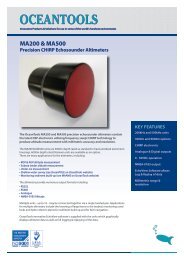

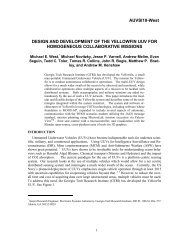
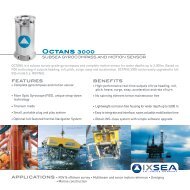
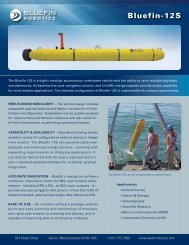
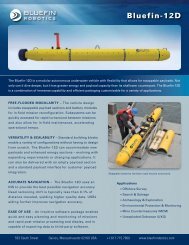


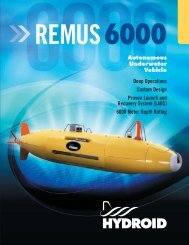


![Sonardyne Wideband Sub-Mini 6 [8270, 8271].pdf - AUVAC](https://img.yumpu.com/44408971/1/190x245/sonardyne-wideband-sub-mini-6-8270-8271pdf-auvac.jpg?quality=85)


